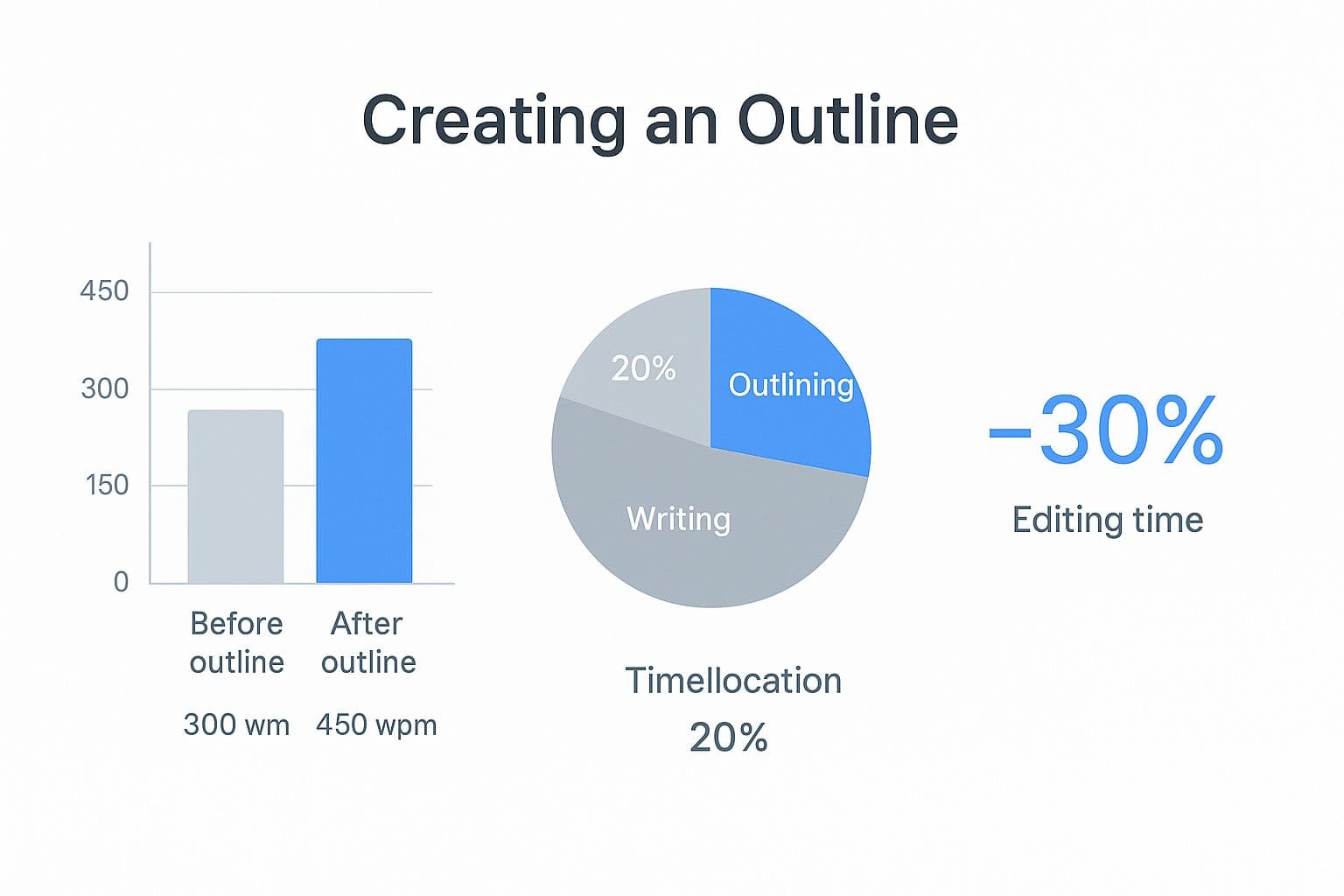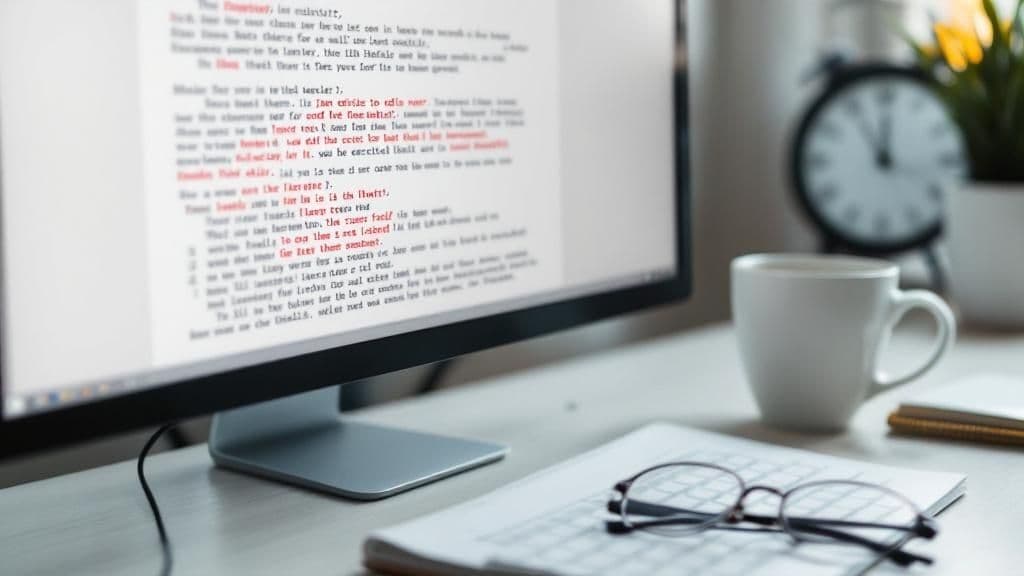How To Write Faster And Better: 7 Effective Tips
Master how to write faster and better with proven strategies from professional writers. Improve your speed and quality today with actionable tips.

The Truth About Speed vs Quality (Spoiler: You Can Have Both)

This screenshot, grabbed from Wikipedia, shows typical words-per-minute (WPM) for things like reading aloud and typing. Notice the huge range? There's no single "normal" writing speed. And here's a little secret: writing faster doesn't mean your quality has to tank. I've seen seasoned journalists crank out amazing content under crazy deadlines. Often, speed actually helps their writing. The real problem isn't speed, it's getting stuck in your head.
That constant second-guessing kills your creative flow. It's like playing a sport – overthinking every move makes you stiff and hesitant. Pros learn to trust their gut, letting the words flow naturally, even under pressure. It's not about rushing, it's about bypassing that "perfectionism paralysis." Get the core message down, then refine. This often leads to tighter, more impactful writing. Plus, writing speed naturally varies based on things like your age and what you're writing. While 25 WPM is sometimes cited as an average, it can be a high bar, especially during exams. Want to dig deeper into the nuances of writing speed? Check this out: Role of Exercise Prescription.
Finding Your Flow State
So, how do you write faster and better? It's all about finding your flow state. That sweet spot where you're totally absorbed, and the words just seem to appear. Timed writing is a game-changer. Set a timer for, say, 25 minutes, and just write. No stopping. No distractions. You'll be surprised how much you produce.
Another trick I use? Placeholders. Stuck on a word or phrase? Slap in a "[TK]" or "***" and keep going. This keeps your momentum up. You can always go back and fill in the gaps later.
This whole approach separates creating from editing. Write freely first, capturing your natural voice and generating raw material. Then edit, polishing for clarity and conciseness. The result? Faster writing and higher quality.
Let's talk about writing speed benchmarks. I've put together this table to give you a sense of how WPM can vary:
Writing Speed Benchmarks by Task Type Comparison of average writing speeds across different writing tasks and experience levels
| Task Type | Beginner WPM | Intermediate WPM | Expert WPM | Quality Impact |
|---|---|---|---|---|
| Essay (Exam) | 15-20 | 25-35 | 40+ | Pressure can decrease quality for beginners, increase for experts |
| 20-30 | 35-45 | 50+ | Quality generally consistent across levels | |
| Blog Post (First Draft) | 25-35 | 40-50 | 60+ | Experts maintain higher quality at higher speeds |
| Creative Writing | Varies widely | Varies widely | Varies widely | Speed less critical than creative expression |
This table shows that while experts generally write faster, they also maintain higher quality, especially under pressure. Beginners often sacrifice quality for speed, particularly in timed situations like exams. The key takeaway? Focusing on finding your flow and improving your process is more important than raw WPM.
Pre-Writing That Actually Sets You Up For Success
The fastest writers I know aren't thinking about speed when their fingers hit the keyboard—they’re in flow because they’ve already mapped out their thoughts. They've embraced pre-writing, which banishes that dreaded blinking cursor and unlocks a smoother, faster writing process. This isn’t about rigid outlines; it’s about building a flexible roadmap.

See? Outlining doesn't just make writing faster; it makes the whole process more efficient, from brainstorming to editing. So, let’s dive into how to make pre-writing work for you.
Outlining: More Than Just Roman Numerals
Forget rigid Roman numerals. Outlining is about organizing your ideas in a way that makes sense to you. I've seen journalists jot down quick bullet points, while novelists swear by sprawling mind maps. The trick is to experiment and find what clicks. For blog posts like this one, I use a modular approach, treating each section like its own mini-project. It helps me wrangle longer pieces without feeling overwhelmed.

This Wikipedia screenshot highlights the different ways you can structure an outline. The takeaway? Find a format that complements your thinking style. Whether it’s a classic hierarchical structure, a free-flowing mind map, or a simple bulleted list, the goal is to create a guide that helps you write more effectively. And don't forget to consider your reader. A well-structured outline translates to a seamless reading experience.
Research Organization: Taming the Information Beast
Research can easily turn into an information black hole. My solution? A "two-bucket" system. One bucket holds the big-picture background info, while the other is reserved for specific data points and examples. This keeps everything organized and makes it easy to pull out relevant details when I'm actually writing. When I was researching AI writing tools like TypeBoost, I used one bucket for general AI trends and another specifically for TypeBoost's features. This separation kept my research focused and readily accessible.
Templates: Speed Without Sacrificing Originality
Templates are lifesavers for recurring content like emails or social media posts. The secret is to make them your own. I have a personal library of templates that I constantly tweak and adapt. This ensures my writing stays fresh and authentic while still saving me time. It's like having a pre-built foundation that I can customize to fit each project. This blend of structure and personalization helps me maintain consistency without falling into repetitive patterns. Remember, templates are a starting point, not a straitjacket.
Let's take a closer look at how different pre-writing techniques stack up against each other:
Pre-Writing Techniques Effectiveness Comparison Analysis of different pre-writing methods and their impact on writing speed and quality
| Technique | Time Investment | Speed Increase | Quality Impact | Best For |
|---|---|---|---|---|
| Brainstorming | Low | Medium | Medium | Generating initial ideas |
| Mind Mapping | Medium | Medium | High | Exploring connections between ideas |
| Outlining (Traditional) | Medium | High | High | Structuring complex pieces |
| Outlining (Modular) | Medium | High | High | Long-form content, blog posts |
| Two-Bucket Research | Medium | High | High | Research-heavy writing |
| Templates | Low | High | Medium | Repetitive content, emails |
This table provides a quick overview of how various techniques can influence both the speed and quality of your writing. As you can see, different approaches suit different needs. Experiment to find what works best for your workflow. The goal is to find the methods that help you generate ideas, organize your thoughts, and ultimately, write more effectively.
Drafting Fast While Keeping Your Authentic Voice

This screenshot shows Grammarly's interface, with its real-time feedback and suggestions. See how it integrates right into your writing flow? This kind of immediate feedback really speeds up editing and helps polish your work as you go. But getting words down quickly doesn't mean you have to sacrifice your unique style. It's about finding the right tools and methods to get your thoughts onto the page efficiently.
Timed Writing Sprints: Your Brain's Secret Weapon
One thing I’ve found incredibly helpful is timed writing sprints. I set a timer for 25 minutes and just write. No editing, no checking emails, no distractions. It’s like a little race against the clock, and honestly, the pressure usually helps my creativity, rather than hindering it. It forces you to prioritize getting those initial ideas down without getting bogged down in details. This focus on output, not perfection, gets that first draft done fast.
Strategic Placeholders: Keep the Momentum Going
Here's another trick: strategic placeholders. Whenever I get stuck on a specific word, a phrase, or even a whole section, I just type "[TK]" (short for "to come") and move on. This keeps me from breaking my flow and lets me deal with those gaps later during editing. Think of it like a roadmap with checkpoints, allowing for a continuous writing journey. For instance, if I can’t quite find the perfect analogy, I'll use a placeholder and come back to it once the core writing is done.
Dictation: Unlocking Your Natural Speaking Voice
Don't underestimate the power of dictation software! Speaking your thoughts out loud often unlocks a more natural, conversational tone. I've found this especially true for blog posts – dictating helps me capture my authentic voice much easier than typing. Speaking engages a different part of your brain, bypassing that "overthinking" that can slow us down. This is a game-changer when you're aiming for speed without sacrificing quality. Plus, there's even research that suggests a connection between writing speed and spelling accuracy! Who knew writing faster could actually improve your spelling? Check out this study for more info!
Keyboard Shortcuts That Actually Matter
While it might be tempting to memorize every keyboard shortcut under the sun, I’ve found that just a few key ones make the biggest difference. My holy trinity? Ctrl+C, Ctrl+V, and Ctrl+Z. Copying, pasting, and undoing are the unsung heroes of efficient editing. Keeping your fingers on the keyboard and minimizing mouse-work makes the whole process so much smoother and faster. These small actions, when streamlined, add up to significant time savings. Trust me, mastering these basics will dramatically reduce your writing time.
Smart AI Integration Without Becoming A Content Robot
AI is transforming how we write, but using it incorrectly can make your content sound, well, a bit robotic. I've chatted with a lot of content creators who have successfully integrated AI into their workflow, and the secret sauce is knowing which tasks to automate and which ones need that human touch. Think of it as enhancing your creativity, not replacing it.
This screenshot shows a typical ChatGPT interface, waiting for your instructions. See how simple it is? It's like a blank page, just begging for some creative input. The main takeaway here is how easy these tools are to use. Anyone can dive in and start playing around.
Prompting for Creativity, Not Just Content
There's a real art to crafting effective prompts. Instead of asking AI to churn out an entire article (which, let's be honest, can sound a little bland), try using it for brainstorming or generating different versions of a sentence. For example, when I'm struggling with a headline, I might ask ChatGPT to give me ten alternatives based on my current draft. This helps me uncover new perspectives I might not have thought of on my own. You might find this interesting: content creation automation. It's all about treating AI like a brainstorming partner, not a ghostwriter.
Research Acceleration Without Losing Critical Thinking
ChatGPT can be a game-changer for research, quickly summarizing important points or gathering relevant information. But don't just blindly accept everything it throws at you. It’s crucial to double-check facts and interpret the data yourself. Think of AI as a super-efficient research assistant who still needs your guidance and critical thinking. You’re the one in charge, making sure everything lines up with your overall message and goals.
Grammarly: Friend or Foe?
Tools like Grammarly are fantastic for catching typos and grammar slips. However, sometimes their suggestions can make your writing lose its unique flair. Learn to recognize when Grammarly's advice is genuinely helpful and when it's best to trust your own judgment. Your individual writing style is what sets you apart, so don't let an algorithm smooth it all away. For example, if Grammarly suggests changing a phrase you love, even if it's a bit unconventional, don't be afraid to stick with it if it truly captures your voice.
Avoiding the Generic AI Trap
The biggest downside of AI writing is the risk of sounding like everyone else. To avoid this, use AI strategically for tasks like outlining, brainstorming, and basic edits. But when it comes to the actual writing, always inject your own personality, experiences, and insights. Remember, your voice is what makes your content special. It's what resonates with your readers and builds a loyal following. Don’t sacrifice that for the sake of speed and efficiency. Your unique perspective is incredibly valuable, so let it shine through in everything you create.
Editing That Improves Everything Without Taking Forever
So, you’ve got a draft. That's awesome! But here's the thing: good writing isn't just about getting words on the page. It's about polishing those words until they shine. And no, that doesn't mean spending weeks agonizing over every sentence. Even professional editors have secrets to make this whole process faster, and I’m going to share some with you.
The Multi-Pass Method: Editing Like a Pro
Think about trying to clean your entire house in one go. Chaos, right? Editing's the same. The multi-pass method is like cleaning one room at a time. First, you tackle the big stuff: the overall structure, the flow of ideas, the strength of your argument. Then, you zoom in on the details at the sentence level—making sure everything is clear and concise. Finally, you do a sweep for typos and grammar errors. This targeted approach is way more effective than trying to do everything at once. Check out these editing tips for writers for more on this.
Prioritize for Impact: Tackle the Big Stuff First
Focusing on the high-impact edits first saves you tons of time. Restructuring a confusing paragraph, for example, has a way bigger impact than fixing a comma. Think about it like this: even something as basic as handwriting speed can affect overall writing ability. Handwriting difficulties affect about 34% of kids, and it’s interesting to note the gender difference: 67% of boys and 33% of girls experience these challenges. Here are some more insights on that. Just like addressing legibility early helps with handwriting, tackling structural issues in your writing early on makes all the later edits smoother and more effective.
Developing Your Editor’s Eye: Spotting Your Weaknesses
We all have our writing quirks. Maybe you overuse adverbs, maybe you love a good run-on sentence (guilty!). The key is to become aware of your own patterns. Track your edits and you’ll start to notice the things you tend to get tripped up on. This lets you proactively address them. Think of it like a baseball player analyzing their swing – understanding your habits lets you target specific areas for improvement. Tools like AI for brainstorming can also help you refine your ideas in the early stages.
Practical Self-Editing Techniques: Making It Work
Take a look at this screenshot. It's the Hemingway Editor, a tool that highlights complex sentences and suggests simpler alternatives. See how it visually flags areas for improvement? This is incredibly helpful for spotting readability issues fast.
Effective self-editing isn’t just about reading your work; it's about engaging with it in different ways. Try reading aloud – you’ll catch awkward phrasing you wouldn’t notice otherwise. Or print out your draft and read it on paper. Getting some distance, like a painter stepping back from the canvas, can reveal hidden flaws.
Creating Writing Systems That Actually Stick

This screenshot from Wikipedia's page on Habit shows just how cyclical forming a habit can be. See that cue-routine-reward loop? That's the core of how habits, writing habits included, are made and reinforced. Get this loop down, and you’re on your way to a writing system that actually lasts.
Let's be real, knowing a bunch of writing hacks won't get you anywhere if you can't make them stick. This isn’t about forcing yourself into a strict daily writing schedule. It's about building a writing system that fits into your life, not the other way around. It’s kind of like creating a personalized workout plan. You wouldn’t walk into the gym and try to bench press 500 pounds on day one, right? You’d start small, stay consistent, and gradually ramp things up. Writing is no different.
Designing Your Ideal Writing Environment
It’s amazing how much your surroundings can affect your writing. Personally, I need natural light and a clean, uncluttered desk. But I’ve got writer friends who thrive in busy coffee shops or even perched on slightly uncomfortable chairs – they say the mild discomfort keeps them sharp. The point is, you need to figure out what works for you. Maybe it’s a designated writing space, a specific playlist, or even a certain scent in the air. You want to create an environment that tells your brain, "Alright, time to write."
Experiment and see what clicks.
Habit Stacking: The Power of Small Wins
Want to build a new habit? Try "habit stacking." It's seriously powerful. Already have a solid morning coffee ritual? Tack on 15 minutes of writing right after. You're connecting the new habit (writing) to an existing one (coffee), which makes it way easier to maintain. These small, consistent wins create real momentum and make the habit stick. This works because you’re tapping into your existing routines, which means less mental effort to establish a new one.
Motivation and Accountability: Staying on Track
Motivation comes and goes. We all know that. That’s why accountability systems are crucial. Find a writing buddy, join an online writing community, or even just tell a friend about your writing goals. Having that external accountability can be a game-changer when you’re feeling uninspired. And while you’re at it, think about SEO. Make sure your content is easily discoverable. A good blog post SEO checklist can really help with that. Sharing your progress, no matter how small, reinforces your commitment and keeps you moving forward.
Navigating Creative Slumps and Busy Periods
Life throws curveballs. Some weeks you’re drowning in work, other times the creative well runs dry. The trick is to build flexibility into your writing system. Instead of obsessing over a daily word count, set a weekly goal. This gives you the freedom to adjust based on what else is going on. Even during crazy-busy times, short bursts of writing – just 10 or 15 minutes – can help maintain that all-important momentum. Remember, it’s not about being perfect, it’s about making progress. Even if you’re in a slump, engaging with the writing process, even briefly, keeps those writing muscles warm and ready to go.
Your Personal Roadmap To Writing Transformation
Let's get real about writing. This isn't about some generic, one-size-fits-all approach. This is about your writing, your goals, and your personalized plan to get there. Think of it as building a custom roadmap, guiding you towards writing faster and better.
Honestly Assessing Your Current Writing Process
First things first: brutal honesty. Where do your writing wheels get stuck in the mud? Is it brainstorming that leaves you staring at a blank page? Maybe drafting feels like pulling teeth. Or perhaps it's the dreaded editing process that keeps you up at night. Do distractions constantly derail your train of thought? Or does perfectionism have you glued to the delete key? Grab a notebook and dedicate 15 minutes to some serious self-reflection. What’s working? What’s slowing you down? This isn't just navel-gazing; it’s crucial for identifying your biggest bottlenecks. Understanding where your time actually goes is the first step towards building writing systems that truly work. If you’re looking for some helpful strategies, check out this article on stopping wasting time.
Identifying Your Bottlenecks and Prioritizing Improvements
Once you’ve identified those writing roadblocks, it's time to prioritize. Which improvements will give you the biggest return on your effort? If outlining feels like your personal kryptonite, focus on conquering that first. If editing takes you an eternity, explore some techniques to make it smoother. Don't try to fix everything at once – that's a recipe for burnout. Small, targeted improvements are much easier to maintain. For example, if distractions are your downfall, creating a dedicated workspace and scheduling specific writing times could be your first major victory.
Setting Realistic Timelines and Tracking Progress
Remember, Rome wasn't built in a day, and neither is a flawless writing process. Be kind to yourself and set realistic expectations. You’re not going to magically double your writing speed overnight. Start small. Maybe aim for 20 minutes of distraction-free writing or completing a first draft without the urge to edit. Tracking your progress can be helpful, but don't become obsessed with the numbers. The real goal is to build consistent, positive habits, not stress over arbitrary metrics. If you’re interested in exploring AI-powered tools, this guide on an AI writing assistant might be useful.
Navigating Setbacks and Adapting Strategies
Let's be honest, there will be days when you fall off the writing wagon. Life happens. The important thing is to hop right back on. Don’t beat yourself up over missed deadlines or unproductive days. Acknowledge the setback, adjust your plan, and keep moving forward. This is a marathon, not a sprint. Your writing process is going to evolve as your needs and projects change. Be flexible, experiment with different techniques, and find what works best for you. That's the key to sustainable writing success.
Ready to give your writing workflow a serious boost? Check out TypeBoost, a smart way to use AI prompts system-wide: https://www.typeboost.ai/en